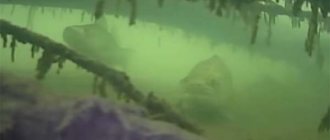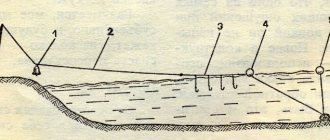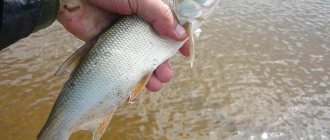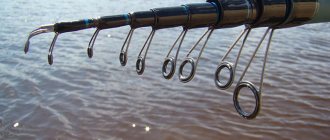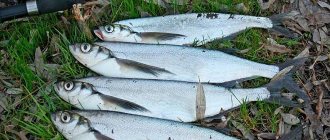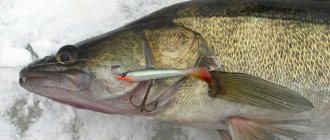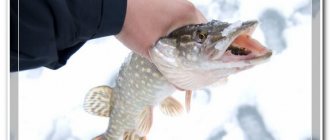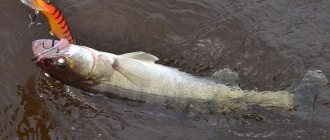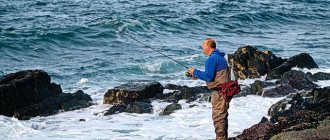When going to a pond with live bait, especially during periods of active hunting by predators, every fisherman can count on an excellent catch. The main thing is to assemble the tackle correctly and know the techniques for catching different types of fish.
The cast is performed once. Using an additional float and weight, we adjust the range and horizon for catching predators - these are just a few of the advantages of this fishing. Properly assembled gear, choice of fishing location and bait with bait - such knowledge will help a novice amateur catch a trophy specimen of pike or pike perch.
Elastic band diagram
Depending on the type and size of the trophies, you will need to make some changes in the thickness of the line, the size of the hooks and the length of the leashes. But the basic scheme of such equipment is the same for all types of bottom fishing rods. It got its name from the inclusion of a piece of rubber in the design.
Large cargo is transported by boat or thrown from the shore. A piece of nylon cord is attached to the sinker. A piece of 1-2 meters is quite enough for casting. Several meters of rubber are attached to the cord. The rubber insert is connected to the main line, on which leashes with hooks are located. All individual sections of the tackle are attached to carabiners.
This is a schematic, brief description of the gear. The main thing is to know how to make this type of gear for predators.
Benefits of using a rubber band for catching pike perch
- Installed and removed once during the entire fishing trip;
- Rubber cushioning prevents the line from breaking during fishing;
- it does not need to be thrown into the water after each bite;
- when used, there is no noise that scares away fish;
- You can catch pike perch around the clock without going far from the shore;
- You can catch any other fish by simply replacing the hooks and bait.
The main feeding time of the predator is at dusk or at night. If visibility is poor, it is difficult to use a spinning rod both from a boat and from the shore. An elastic band for pike perch will help you catch fanged fish without any inconvenience while being on the shore until the morning.
Tackle elements
Any type, be it Astrakhan or classical scheme, is made of several parts:
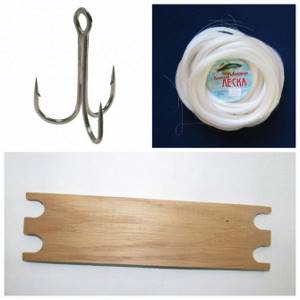
- Reel . This part is required for stowing fishing lines and hooks when transporting or storing fishing rods. It can be made from a piece of board, plywood, dense foam or a piece of plastic panel. The main rule is that the entire supply of fishing line must be placed on it and the hooks must be securely fixed. All edges should be smooth so as not to cut the wood.
- Main forest . The choice of its cross-section depends on the size of future production and water transparency. If you take a thick line, you may not be able to wait for a bite from a cautious predator. But a thin forest will not be able to withstand the jerks of large prey. Therefore, it is important to maintain a balance. For catching small perches, a cross-section of 0.16-0.20 mm will be sufficient. For pike, it is better to set from 0.3 mm.
- Leash . The choice depends on the size of the trophies and their type. For pike you need to install a steel leash, but for perch a simple line or braided cord will be enough. The minimum number of them on one tackle is 5 pieces.
- Hook . When catching predators in places with possible obstacles, it is better to use offset hooks. Fishing from the shore or boat will require the installation of leashes with double or triple hooks. The choice of number directly depends on the size of the future trophy.
- Sinker . Normal conditions for catching predators depend on its size. If you plan to fish on a river with a strong current, multiply the weight of the load several times. It must withstand the load of water pressure and rubber tension while remaining in place. If you take the same sinker for pond fishing and perch fishing, you risk not delivering the tackle to the right place and, in general, tearing off the line when casting. But this rule only applies if you have to fish from the shore. A reliable boat will allow you to carry any cargo over a given distance. In order to remove such a fishing rod, attach a float to the carabiner on the cord on the line. This way, you can easily find the location of the sinker and quickly pull it out without unwinding or stretching meters of rubber when searching for the casting location.
- Rubber . For equipment, it is better to use round, as it was previously called “aviation” rubber, which can stretch 3-4 times. A rectangular section is not suitable. The sharp, thin edges quickly begin to become damaged and crack under frequent tension.
- Carbines, swivels . These parts make it easier to install the gear and prevent the leads from twisting.
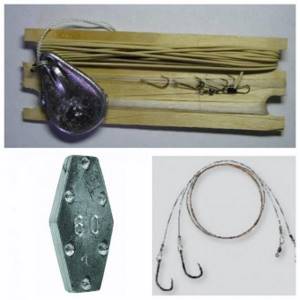
Making your own tackle is quite simple. Let us examine in detail the manufacture of the basic donkey circuit.
Fishing methods
After the donk is made, the optimal casting location is selected for successful fishing. The location of the hooks in the water is taken into account. Casting methods - from the shore or from a boat. The rubber band for fishing must first be unwound and laid in rings on the shore. It is also recommended to secure the reel in advance. If the fishing is on the river, you need to lower the weight further upstream. This will help level out minor shifts in the gear.
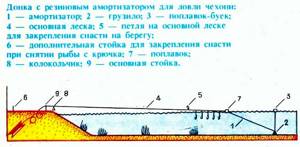
Fishing with an elastic band and casting from the shore:
- Grab the end of the rope from the elastic side.
- Unwind the weight, rotating movements from bottom to top.
- When the speed is maximum and the line is tilted towards the water by 40-60°, release the rope.
- Take the reel so it didn't fly into the water.
It is important that after diving the rubber is not stretched. Otherwise, constant load may affect the integrity of the rubber part of the gear. How to choose a good and inexpensive PVC boat for fishing - practical advice
Using a boat simplifies the above procedure and increases the accuracy of gear location. The current will show where it is best to lower the weight into the water; first, you can examine the bottom topography using an echo sounder. You can also sprinkle bait there.

Classic rubber band, live bait – do it yourself
Let's prepare for work:
- Big load. You can use lead braid from power cables or cast lead weights.
- Round rubber.
- Stock of main scaffolding of the required section.
- 5–6 leashes made of fishing line or steel thread.
- Reel.
- Hooks, carabiners and swivels.
Assembly steps
The work is carried out in several stages:
- At the 1st end of a meter-long piece of nylon cord we attach a load . In the middle we make a loop for the hand. This way, it will be easier for you to cast the tackle over a long distance.
- At the 2nd end we attach a carabiner to connect it with a section of the main line . Many people use a direct connection between the weight and the rubber, but this design will quickly come off. The length of the rubber insert depends on the casting distance. If the place is located 20-30 m from the shore, the rubber section should be 10 m or more.
- We attach a carabiner with a swivel to the end of the rubber . We connect it with a section of the main line, on which loops or carabiners are tied for attaching leashes. Depending on the species of fish or fishing conditions, the thickness and length of the leashes may vary. Every fisherman should have a supply of leashes with different hooks and sizes.
- We attach the leashes to carabiners or “loop to loop” . We knit spare leashes of different lengths and tie them to the hooks in a figure eight. If possible, it is better to use small carabiners or tie a loop at the end.
- We fasten the hooks . To do this, we stick them into the body of the donkey. If wood or plastic is used to make the reel, glue pieces of foam plastic to its edges and attach hook tips to them.
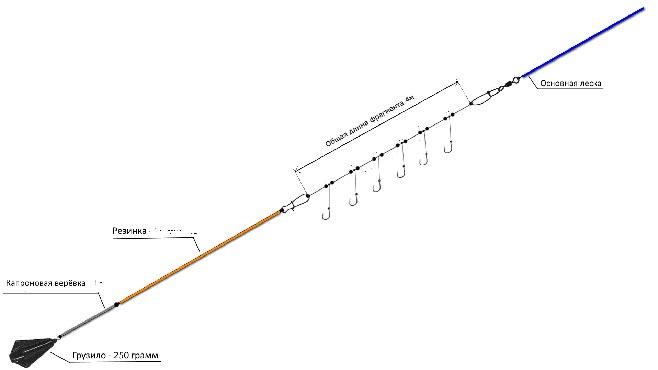
Our gear is ready.
Important! For successful fishing, experienced fishermen advise stocking up on fishing rods.
Choosing a place and time of fishing
You can catch large predatory fish with a rubber band, but landing the trophy will be difficult and memorable. To do this, it is important to know the best time, weather conditions, hunting and resting places for predators. Let's try to answer a few basic questions.
Where is the best place to fish?
The choice of fishing spot depends on the type of fish. While pike perch likes to hunt in areas of reservoirs with a sandy or rocky bottom, pike or perch prefer muddy surfaces. On a river or lake, the choice of location can be radically different. Pike prefers places with a steep bank. Her favorite places are small creeks, bays, and snags. But for elastic fishing, it is better to find a point on the border of clear water and thickets of aquatic vegetation.
Pike perch will be attracted to a small bay with calm water or an island in the middle of a large river with a sandy bottom. In any of these places there are sure to be schools of young peaceful fish, hunting for which a predator comes out.
What time of year and day?
There are 2 periods in the year when fishermen forget about all household chores. This is the time of spring feeding, when predators are actively feeding after winter, and you can go fishing at any time. Pike or pike perch approach places of accumulation of peaceful fish that are gaining fat. During this period, the best place for fishing is the confluence of meltwater streams, from which food for prey and oxygen enter the reservoir.
The second time of active fishing is pre-winter. The first drop in temperature causes predators to become more active and begin to gain fat before winter. The time for autumn food is coming. A rubber band for pike or perch allows you to quickly secure an excellent catch and gives pleasure when fishing for a strong opponent.
Summer is the time when fish are caught in the wee hours. The water has cooled, large individuals go hunting, and small ones return from night fishing. If the fisherman manages to find the place where they meet and throw the rubber band at the right time, the result is guaranteed. In general, summer is a time when predators slide into deep holes with cool water and hunt in the rare hours of dawn.
But if there is a sudden drop in temperature, predators try to catch up and become more active.
Influence of weather conditions
Everything is simple here. If a north or east wind blows, it is better for fishermen to stay at home. Powerful southwestern or western winds blow, you can safely go fishing. Strong excitement lifts crustaceans and other food of peaceful fish from the bottom, and it begins to actively move throughout the reservoir. The predator will definitely react to this.
High atmospheric pressure - the fish will be passive and difficult to find. This is due to a decrease in the amount of oxygen in the water. The fish rolls into deep holes with springs and stands there. Catching pike perch with an elastic band will be successful and effective if strong waves push the thermocline away from the shore. Warm water sinks into the depths, followed by schools of small fish. At the depths they will be guarded by fanged predators.
What to catch
The elastic band can be safely called a universal tackle, since it is suitable for fishing almost any fish, both peaceful and predatory. In the warm season, crucian carp and tench are used to catch crucian carp and tench on lakes and reservoirs. In river bays and other sections of the river where there is no current or it is insignificant, the main target is bream, ide, and silver bream.
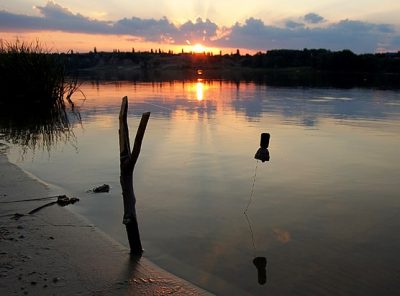
Donka with a rubber shock absorber is incredibly popular in catching sabrefish, especially during the pre-spawning period, when it brings catches of tens of kilograms. You can purposefully catch pike with live bait, and many fishermen also use rubber bands when hunting for pike perch at night. If a worm is used as bait, there is often another predator on the hook - perch.
Catching peaceful inhabitants of a reservoir involves feeding. The bait balls are delivered to the point either using a special boat attached to one of the leashes, or thrown by hand if the hooks are not too far from the coastline.
Fishing technique and tactics
For effective fishing, you need to cast to the right place and not lose your gear. It's good if you have a boat. Then the casting issue is easily resolved. We unwind the tackle, go by boat to the desired place and lower the sinker. In this case, in order to easily remove the load from the water, we tie a line with a bright float to it. Now after fishing you can easily find and remove the cargo from the bottom. Successful fishing for pike perch is possible even in urban areas, especially when predators go to spawn.
Let's take a closer look at the fishing technique if the boat is inaccessible to the fisherman:
- We unwind and carefully place the elastic band and the main line on the ground . In order not to lose the tackle when casting, we unhook the carabiners, lines and leashes in the area between the main conductor and the elastic band and connect these parts directly.
- Having unwound and laid the line and elastic in a clean place, we take the cord with the load by the loop and throw the donkey to the place you like, or rather, a little further . It is important that after the rubber is loosened, the hooks are on the border of vegetation and clean water.
- We drive 2 pegs into the soil . One is near the water, and the other is 4–5 meters from it. The second one will be used to secure the tackle when replacing bait and live bait, and the first one will serve as a support for installing a bite alarm. Signaling devices are used in different ways. If we go night fishing, it is better to use a luminous or electronic bell that indicates in the dark which gear has worked. During the day we use a simple bell or a lump of damp soil stuck on the wood.
- We select the line from the water to the point where it connects with the rubber . Before disconnecting the carabiner, we recommend fixing the elastic band so that it does not go into the water if you move it carelessly.
- We attach a section of the line with leashes with carabiners, and gradually release the line . When it loosens, we can determine whether the cast is correct. But we are in no hurry to make adjustments. We take the hooks out of the water and attach live bait or bait.
- Only now can you adjust the casting and finding the hooks. If the leashes do not reach the site a little, we attach a float in the front part of the main line; it increases the range of lowering the hooks to the bottom. If the tackle is thrown with a flight, on the far side, near the last hook, we hook sheet lead. The additional weight lowers the bait exactly to the intended location.
- Self-made equipment allows you to install the required number of hooks. Right on the pond, by quickly unhooking the leash with a large hook and setting a smaller number, you can catch perch if the pike perch doesn’t want to bite today.
- We carefully begin to reel in the slack in the line , after we feel a slight tension, we fix the cord on the first peg. We attach the alarm and move on to casting the next tackle.
- After the bite, we wait for a new series of jerks. We hold the line in our hand and cut smoothly and carefully.
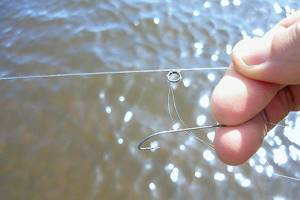
Important! Don't forget to pack an extractor and a reliable yawner in your backpack. This way you will protect your hands from the predator’s teeth and quickly remove the hook from the fish’s mouth.
Technique for fishing with a rubber band and casting from the shore
Let's look at all the tricks of fishing with an elastic band, starting with the obvious advantages of the method:
- The load is cast once, and there is no need for repeated casts to scare away the fish.
- The elastic band does a good job of absorbing the jerks of strong fish.
- The process of changing bait is simplified - it is done by weight.
- Baited hooks always return to the same place.
- The donka with an elastic band has excellent sensitivity to bites.
There is only one drawback - without certain casting skills, you can seriously tangle the line. However, if everything worked out, further fishing will not be difficult.
Carefully study the video, it clearly shows how to cast and not tangle the line.
How to throw (start) a donk with an elastic band
- Before casting, all the gear, from the elastic to the reel, is unwound and laid out in a spiral on the shore, so that there is no interference from stones or vegetation.
- A weight is securely tied to the end of the elastic band.
- The reel with a supply of fishing line is attached to a peg (you can hold it in your free hand).
- Standing on the side of the laid out fishing line, the fisherman casts the load to the desired place. If this is a river, you should take into account the drift of the load by the current before it sinks to the bottom.
- A pause of 5-10 minutes is taken so that the load settles securely to the bottom.
- A section of fishing line is pulled ashore where the leashes will be attached. Above it, a loop is made on the fishing line, which clings to a specially installed slingshot, so that there is free access to all leashes.
- The leashes are hung, the bait is attached, and the line is carefully released into the water.
- Excess fishing line is wound on a reel, which is attached to a pre-driven peg.
- All that remains is to attach a guard (a bell or other bite alarm) and wait.
- If casting is carried out from a boat, the current of the river must also be taken into account. Sometimes it makes sense to lay out the tackle along the shore, against the flow of the water, in order to start the boat ride from there, and in the right place lower the load with the buoy to the bottom.
- If you plan to fish at shallow depths in the summer, you can wade the load.
These are the general rules for throwing a rubber band. But the process of catching a particular fish can vary significantly.
Pike perch on a spinning rod - a guide to choosing tackle, baits and a story about the technique of catching a deep-sea fanged hunter.
The best fishing knot - it does not come undone, does not reduce the strength of the connection and does not move, learn how to knit a figure eight correctly.
How to prepare bait for bream - the best recipe, list of preferred ingredients and flavors.
Catching sabrefish with an elastic band
Chekhon is the most popular fish that can be caught without a rubber band.
The rubber band seems to be specially created for catching sabrefish - it is this tackle that allows you to get the richest catch. The best time to catch this fish is from May to September. She loves shallow rocky or sandy sections of the river, usually walking in schools, closer to the surface of the water.
Lure
- A mixture of breadcrumbs and millet porridge (1 to 1) is good for baiting sabrefish. The finished cooked mixture is placed in a feeder made of fine mesh. It is installed at a distance of 5-6 meters from the location of the hooks upstream. It is tied to a buoy at the surface of the water and secured at the bottom with a weight.
- You can also use a plastic bottle with frequently made holes, and even uncooked millet groats or breadcrumbs as bait.
- The bait is gradually washed away by the water and goes downstream, thereby attracting shoals of sabrefish to the fishing spot.
Bait and fishing technique
- The best option for sabrefish is maggots, 4-5 pieces per hook. Closer to autumn you can use fry.
- The bait should be located closer to the surface of the water, so be sure to install a float between the elastic band and the area with the leashes. It can be a foam ball with a diameter of about 5 cm, or a hollow factory one with good buoyancy.
- The saberfish reacts more actively to moving bait, so it is necessary to “play” with it. The line is held in the hand, a sharp jerk is made, then smoothly released into the water until it stops. Pause for about 3-4 seconds, and the cycle repeats. Sometimes you can add variety to the game by changing the frequency and duration of jerks.
How to catch crucian carp with an elastic band
Crucian carp, especially small ones, go very well on elastic bands
- This is perhaps the most uncomplicated type of fishing. Crucian carp loves everything, and you can use bread, hominy, worms, maggots, and bloodworms as bait.
- The most important thing is to feed the fishing spot well, and in a well-chosen area (and crucian carp can be found everywhere) you will not be left without a catch. This fish loves fragrant baits, so the best option would be to use pureed sunflower, flax or hemp seeds in their composition.
- To make fishing more effective, you can put feeder spring feeders filled with bait on the fishing line between the leashes. The rubber band is released into place and shaken vigorously so that the nutritional mixture comes out of the feeders. This procedure is repeated 2-3 times. As a result, a well-fed fishing zone is formed exactly in the place where the crucian carp will be waiting for bait on the hooks.
Catching bream with an elastic band
Bream is a large schooling fish, which makes it possible to successfully catch it with a rubber band.
All fishermen know how shy and cautious the bream is. If any technical liquid gets on the tackle, it is better not to use it - you won’t get a bite. So the gum should always be kept perfectly clean.
What are the features of bream fishing?
Lure
Without this, bream cannot be caught. We recommend not using store-bought mixtures as food, but steaming peas. For one bottom fishing rod, about 2 kg, boiled over low heat for 10 minutes, will be enough.
The bait should be scattered over the place where the bait is installed at least one and a half to two hours before the intended fishing. To determine exactly how the hooks will be positioned on the bottom, it is recommended to attach pieces of foam plastic to them and test the fishing line into the water. This way you can clearly see how the fishing line is positioned on the bottom, taking into account the underwater current. The fertilizer is scattered along this trajectory.
Bait
- Bream is a fairly omnivorous fish, but the best option, of course, is medium-sized dung red worms. 5-6 worms are hung on a hook (No. 4-6), the tip is always hidden.
- The leash for bream is usually made 20-25 cm from 0.2-0.25 mm fishing line. The optimal number of hooks is up to 5 pcs.
Catching
- Waiting for bream bites in the daytime is almost pointless. Its time is early in the morning, at dawn, or after 6-7 pm. If you stubbornly plant worms throughout the day, small things will annoy you and are not worth your attention.
- It is difficult to confuse the bite of a bream with another - at first the guard moves slightly back, and then confidently moves forward by 15-20 centimeters. Now you can hook, and, most importantly, do not let the bream go towards dense thickets. The elastic band will help absorb strong jerks. All that remains is to carefully lead it to a place where it can be picked up with a landing net, or to the shallows, where it will lie on its side.
It is obvious that a well-designed bottom fishing rod with an elastic band in the hands of a skilled fisherman turns into a universal tool. And what is also important, fishing with an elastic band can allow you to be distracted by other, more active types of fishing.
primanki.com
Brief recommendations for catching different types of predators
For perch fishing, we recommend using an elastic band with a cross-section of up to 5 mm. Single hook No. 8. The main line is 0.3-0.4 mm, the leads are monofilament 0.25 mm. You should not put more than 7-8 hooks, otherwise such equipment will not increase the catch, but will increase the consumption of bait and the risk of tangling the gear.
Fishing for walleye will require heading to rocky or sandy flats with minimal vegetation. If a predator refuses to bite, try looking for it in the depths. He likes to hide in holes (minimum 3000 mm) with clear water and a rocky bottom.
But you will have to make small changes in the design of the equipment, take an additional sinker weighing 35 g. We make it a sliding type and place it in the space between the rubber and the first leash assembly. The leashes are also sliding, we fix their movement with 2 beads installed at a distance of 500 mm from each other.
Fishing for pike with an elastic band is a gambling activity. Spring pike fishing in muddy water allows you to hook leashes of the same section as the main line. The distance from the end of the rubber to the first leash is from 6 m. It is better to raise such tackle above the bottom. To do this, we fix small floats in the space between all the leashes, which lift the hook with bait and the pike will see the bait at a long distance.
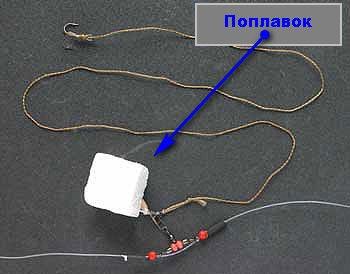
Catching predatory fish will be effective if you use several types of baits in one tackle.
Technique for landing pike perch
When catching pike perch, anglers themselves tend to use a rubber rig rather than a feeder. When caught with a rubber band, you should cast once. And then only the fishing processes should be carried out, as well as the process of replacing the bait itself.
And here's what you need to know: How to weave a fishing net for beginners at home?
Basically, the casting process should be done while using a boat. But if you carry out this process manually, then you should unwind the elastic band and fishing line from the reel and lay it out carefully on the shore. The process of attaching the sinker is carried out, and only then the actual casting of the same sinker. It is necessary to wait a little so that this load sinks to the very bottom.
The casting itself is carried out over the current. Several slingshots should be made, the first one should be installed on the bank and the slingshot should be secured.
The next one must be positioned so that it is between the loop and the elastic band. Next, the elastic is pulled out and the loop is attached to the slingshot.
The process of securing the leashes is carried out and the bait is planted. Then the line is released.
When carrying out the biting process, a fish such as pike perch completely swallows the bait used, and then the process of quickly swimming out of this area occurs. When a pike perch bites, a characteristic bell rings, which means the fish has taken bait and is trying to escape from the hooks.
But the rod, stuck into the ground to secure the equipment, prevents the pike perch from breaking off the hooks. In addition, that rod will not provide the necessary tension necessary for the fish to break the equipment.
Baits and lures
Well-made equipment is only half the battle. Fishing will be successful when you manage to guess the taste preferences of predators. For bait, use only those species of live bait that live in the reservoir. They must be strong and remain alive and mobile for a long time. We do not recommend planting rotan, such live bait will not attract predators, although it is tenacious. For live bait it is recommended to use:
- crucian carp;
- small perches;
- roach;
- ruffs;
- rudd.
The main thing is that the bait is fresh and active. They hook the bait in different ways. Many fishermen recommend hooking single hooks into the upper jaw. Some people like to hook single hooks and other types of hooks under the dorsal fin on predators. There is a way to thread the line through the gills and after removing the leash from the mouth, tie a hook or secure it with a carabiner.
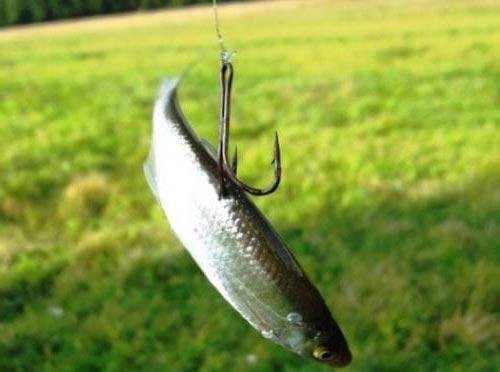
In the fall, predators prefer passive prey, saving energy to accumulate fat in the winter. During this period, you can use sprat and pieces of fish for bait. It is better if the bait has mirror scales so that predators can see prey from a distance. You can tie jigs or small spinners, especially for catching perch. Such baits arouse interest with their game and the smell of the bait.
The introduction of animal complementary foods in combination with the addition of industrial attractants for predators will increase the catch, but such complementary feeding is not needed for active fish.
